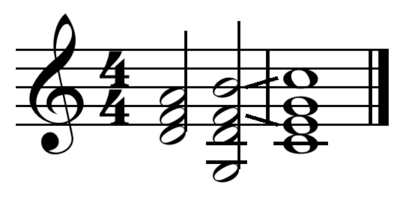Supertonic



In music or music theory, the supertonic is the second degree or note of a diatonic scale, one step above the tonic.[1] It is sung as re in solfege. In music theory, the supertonic chord may be symbolized by the Roman numeral ii in a major scale, indicating that the chord is a minor chord (for example, D-F-A in C major), or iio in a natural minor scale, indicating that the chord is a diminished chord (for example, D-F-A♭ in C natural minor), if in second inversion a six-four chord (A♭-D-F), and if the third is raised an augmented sixth chord (A♭-F♯). If in major or minor, through the lowering of the second scale degree (also the sixth in major), the chord is major (D♭-F-A♭) then it is a Neapolitan 6th chord, N6 or ♭II6. The supertonic may be raised as part of the common-tone diminished seventh chord, ♯iio7.





One variant of the supertonic seventh chord is the supertonic diminished seventh[2] with the raised supertonic, which equals the lowered third through enharmonic equivalence (in C: D♯=E♭).
Pre-dominant (sometimes called "sub-dominant") chords are chords which distinguish chord V as a goal of motion (as opposed to it acting as an embellishing chord within a phrase) they create gravity and harmonic motion towards dominant harmony, and form a fundamental aspect of western tonal music.
The supertonic chord is known as a pre-dominant chord, as it is one of the unique chords which has a natural tendency to gravitate towards chord V and strengthen V as a goal of motion. The supertonic chord lies a fifth above chord V. Descending fifths are a strong basis for harmonic motion and harmonic motion through intervals of fifths is a natural way for chords to progress to one another; the supertonic is one of the strongest pre-dominants and approaches chord V from above through a descending 5th. It is preferable to avoid chord two in root position in the minor mode due to the harsh quality of its diminished intervals, ii6 is a much nicer alternative. This is less of an issue if the chord contains a chordal seventh; indeed, root-position diminished seventh chords are quite common.
Adding a chordal seventh to the supertonic (minor or diminished) does nothing to interfere with its pre-dominant qualities, but rather intensifies their pre-dominant function and also increases harmonic intensity and motion towards dominant harmony. Supertonic seventh chords are such intense pre-dominant chords because they outline the leading note contained in chord V with a dissonance.
"Supertonic" also refers to a relationship of musical keys. For example, relative to the key of C major, the key of D major (or D minor) is the supertonic. Modulation (change of key) to the supertonic is relatively common (by far the most common modulation in modern popular music), though in classical music it is more common to modulate to the dominant or other keys.
In German theory derived from Hugo Riemann, the supertonic is considered the subdominant parallel: Sp/T in major though sP/T in minor (A♭M).